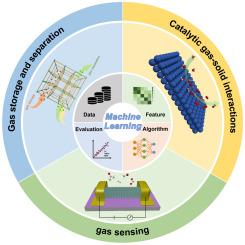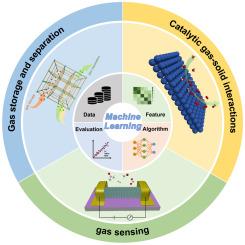气固相互作用材料和设备的机器学习
IF 20.3
1区 化学
Q1 CHEMISTRY, INORGANIC & NUCLEAR
引用次数: 0
摘要
涉及各种化学和物理过程的气固相互作用在气体储存和分离、催化和气体传感等多个研究领域都非常重要。设计和研究气体界面材料和工艺需要对气固界面的结构、化学和电气特性进行全面考虑。然而,由于可用材料数量众多,传统的试错尝试需要耗费较长的开发周期和较高的成本。最近,针对气固相互作用的机器学习(ML)技术的发展充分应对了这一挑战,并为材料设计和性能预测提供了新的见解,因此值得我们进行深入研究和讨论。在这篇论文中,我们回顾了各种 ML 方法在涉及气固相互作用的材料和设备开发中的应用,重点阐述了 ML 模型建立的结构-性能关系。我们还讨论了该领域未来发展的潜在机遇和挑战。本文章由计算机程序翻译,如有差异,请以英文原文为准。


Machine learning for gas–solid interaction materials and devices
Gas–solid interactions that involve various chemical and physical processes are important in various research fields such as gas storage and separation, catalysis, and gas sensing. The design and study of gas–interfacing materials and processes require thorough considerations on the structural, chemical and electrical properties at the gas–solid interfaces. However, due to the large number of materials available, conventional trial-and-error attempts take long development cycles and high costs. The recent advancement of machine learning (ML) for gas–solid interactions adequately addresses this challenge and provides new insights into materials design and property prediction, thus deserving a critical review and in-depth discussion. In this contribution, we reviewed the application of various ML methods in the development of materials and devices involving gas–solid interactions, focusing on the elaboration of the structure–property relationship established by ML models. We also discussed the potential opportunities and challenges for the future development in this field.
求助全文
通过发布文献求助,成功后即可免费获取论文全文。
去求助
来源期刊

Coordination Chemistry Reviews
化学-无机化学与核化学
CiteScore
34.30
自引率
5.30%
发文量
457
审稿时长
54 days
期刊介绍:
Coordination Chemistry Reviews offers rapid publication of review articles on current and significant topics in coordination chemistry, encompassing organometallic, supramolecular, theoretical, and bioinorganic chemistry. It also covers catalysis, materials chemistry, and metal-organic frameworks from a coordination chemistry perspective. Reviews summarize recent developments or discuss specific techniques, welcoming contributions from both established and emerging researchers.
The journal releases special issues on timely subjects, including those featuring contributions from specific regions or conferences. Occasional full-length book articles are also featured. Additionally, special volumes cover annual reviews of main group chemistry, transition metal group chemistry, and organometallic chemistry. These comprehensive reviews are vital resources for those engaged in coordination chemistry, further establishing Coordination Chemistry Reviews as a hub for insightful surveys in inorganic and physical inorganic chemistry.
 求助内容:
求助内容: 应助结果提醒方式:
应助结果提醒方式:


